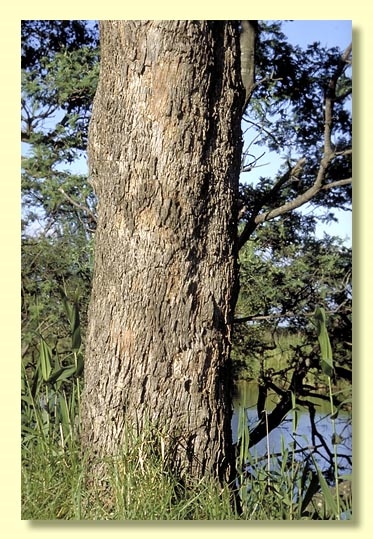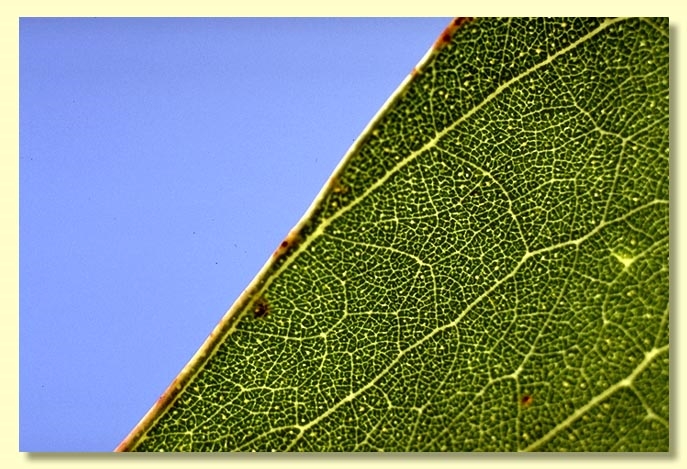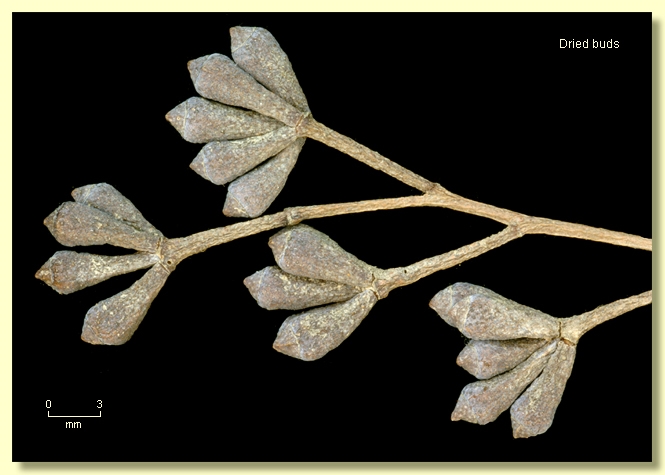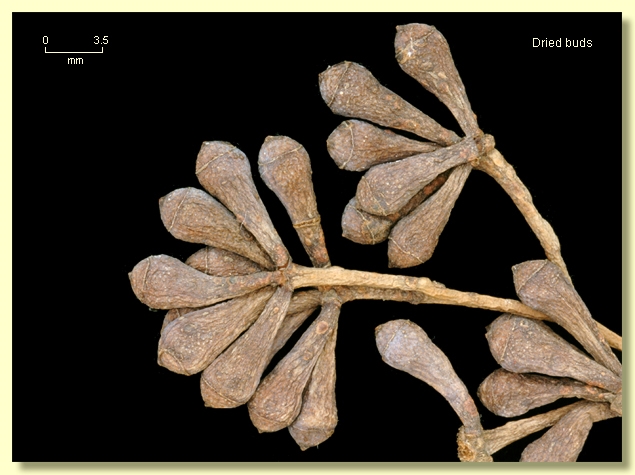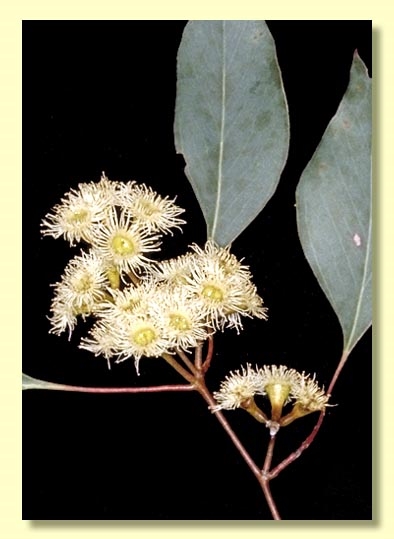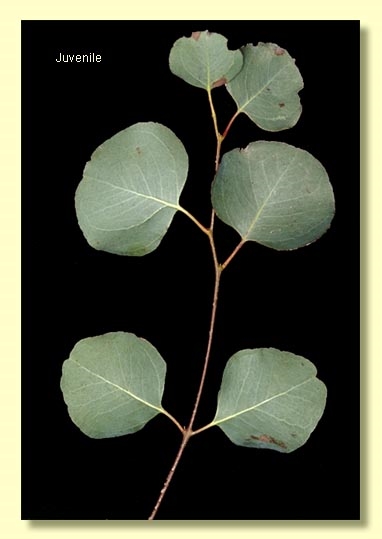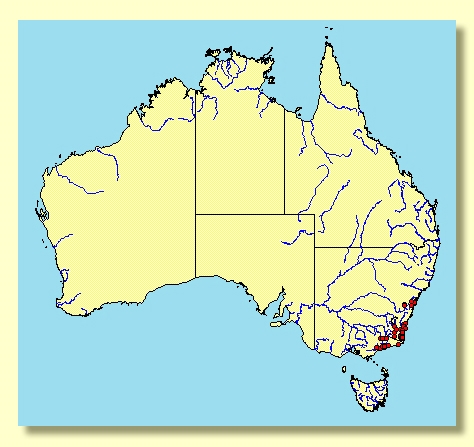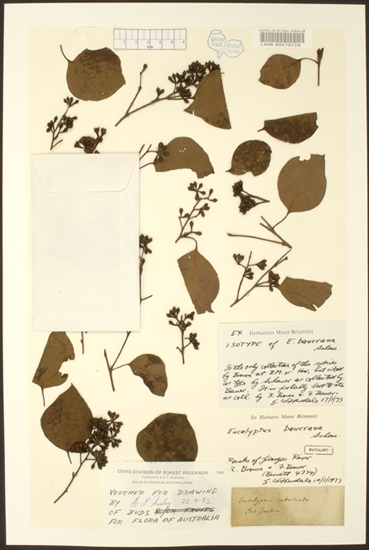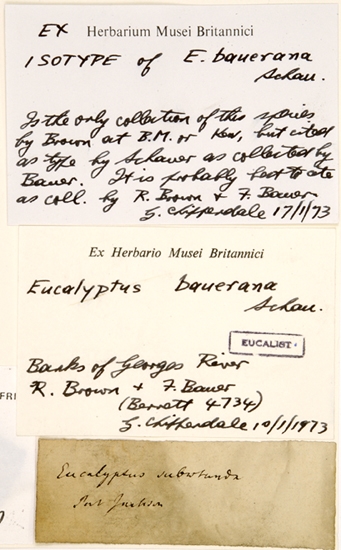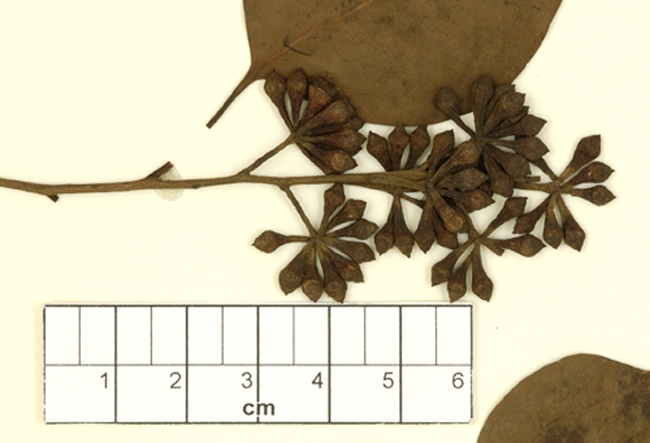Euclid - Online edition
Eucalyptus baueriana
Eucalyptus | Symphyomyrtus | Adnataria | Terminales | Heterophloiae
Eucalyptus baueriana subsp. deddickensis Rule, Muelleria 29(1) 13-14 fig. 1 (2011). T: Victoria: On the bank of the Deddick River, 10 km by road upstream from Ambyne Settlement Road, 37 02'44"S, 148 21'17"E, 18 Aug 2006, K.Rule 8106 and K. Parker; holotype: MEL 23244022; isotypes: AD, CANB, NSW.
Eucalyptus baueriana subsp. thalassina Rule, Muelleria 29(1) 12-13 fig. 1 (2011). T: Victoria: Diggers Rest-Coidamai Road at the Djerriwahrr Creek crossing 37 37'07"S, 144 31'42"E, 16 iii 2005 K.Rule 2005, MEL 2324023 (isotypes: CANB, NSW).
Bark rough over trunk and branches, box-type, grey or mottled grey and white patches, branchlets occasionally glaucous. Crown of mature tree often consisting of juvenile leaves.
Juvenile growth (coppice or field seedlings to 50 cm): stem rounded or square in cross-section, rarely slightly glaucous, smooth or warty; juvenile leaves opposite for 2 or 3 pairs then alternate, petiolate, orbicular to broadly ovate, 3.5–6 cm long, 3.9–8 cm wide, green or slightly glaucous.
Adult leaves alternate, petiole 1.8–4.3 cm long; blade ovate, 5–10.5 cm long, 2–6 cm wide, flat or undulate, base rounded or tapering to petiole, concolorous, dull or glossy, green or slightly glaucous, side-veins greater than 45° to midrib, densely to very densely reticulate, intramarginal vein parallel to and well-removed from margin, oil glands small, obscure or island and intersectional.
Inflorescence terminal compound, peduncles 0.5–1.1 cm long, buds 7 per umbel, pedicels 0.1–0.5 cm long. Mature buds obovoid or diamond-shaped, 0.3–0.6 cm long, 0.3–0.4 cm wide, green to yellow, scar present, operculum conical, stamens inflexed, with outer staminodes, anthers adnate, positioned obliquely at filament tip, cuboid, dehiscing by terminal pores, style long, stigma pin-head, locules 3 or 4, the placentae each with 4 vertical ovule rows. Flowers white.
Fruit pedicellate (pedicels 0.1–0.5 cm long), obconical, 0.3–0.6 cm long, 0.3–0.7 cm wide, rim thin and often split, disc descending, valves 3 or 4, enclosed.
Seeds brown or grey, 0.7–2 mm long, flattened-ovoid, often pointed at one end, dorsal surface shallowly reticulate or smooth, hilum ventral.
Cultivated seedlings (measured at ca node 10): cotyledons reniform to oblong; stems square in cross-section, sometimes glaucous; leaves always petiolate, opposite for 5 to 8 nodes, rarely more, then alternate, ovate to orbicular, 2.5–9 cm long, 4–7 cm wide, base truncate to tapering, green to grey-green.
Flowering has been recorded in January, May, August, September, November and December.
A small to medium-sized red box tree from central and southern coastal New South Wales and coastal eastern Victoria. It is easily recognised by the rough bark, petiolate orbicular juvenile leaves and ovate adult leaves, terminal inflorescences, clavate to diamond-shaped buds, and obconical, thin-rimmed fruit.
Eucalyptus baueriana differs from the related and more widespread E. polyanthemos by the glossy adult leaves (dull in all three subspecies of E. polyanthemos). The related northern species, E. magnificata, has slightly glossy bluish green leaves, and larger, glaucous buds and fruits (non-glaucous in E. baueriana).
Eucalyptus baueriana belongs in Eucalyptus subgenus Symphyomyrtus section Adnataria because the buds have two opercula, ovules are in four rows, seeds are flattened-ovoid, cotyledons are reniform, and anthers are rigid on the staminal filaments. Within section Adnataria, E. baueriana is part of subsection Terminales series Heterophloiae having box bark, terminal inflorescences, buds that shed the outer operculum early, stamens inflexed and the outer stamens sterile (staminodes). Other species in this series are E. rudderi from the Taree area of the North Coast of New South Wales, E. polyanthemos in southern New South Wales and eastern Victoria, E. hypostomatica occurring north from western Sydney to Wattagan State Forest, E. magnificata from the northern tablelands of New South Wales, E. conica from the slopes and adjacent tableland areas of New South Wales north from the Weddin Mountains to central Queensland, and E. fasciculosa, a predominantly South Australian species from Kangaroo Island, lower southern Lofty Ranges and the plains from lake Alexandrina east into western Victoria. A eighth species in the series, E. lucens, is found only west and south-west of Alice Springs.
In 2011 Rule described two new subspecies endemic to Victoria viz. Eucalyptus baueriana subsp. deddickensis, from along the Deddick River west of Tubbut; and E. baueriana subsp. thalassina from near Bacchus Marsh and along the Werribee River. They differences Rule describes, plant stature, leaf size and colour and fruit size, are not uncommon in stands elsewhere in the distribution of E. baueriana in NSW and Victoria.


